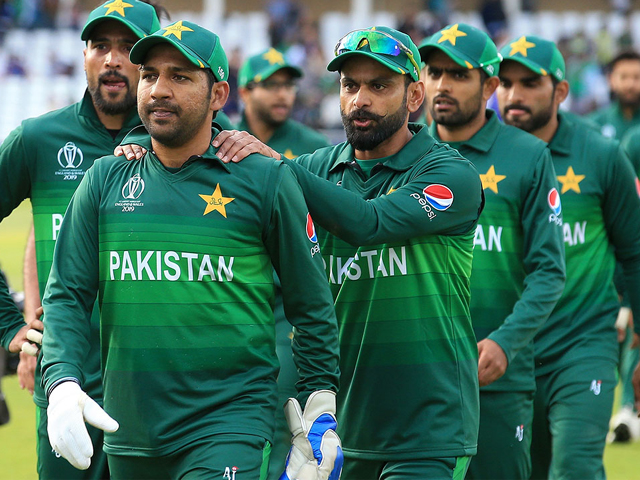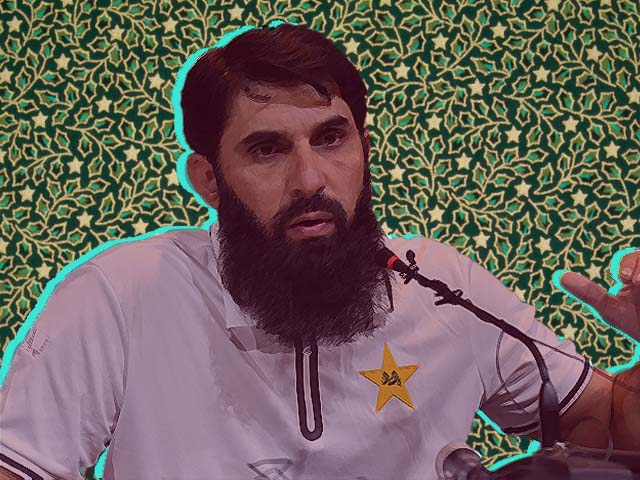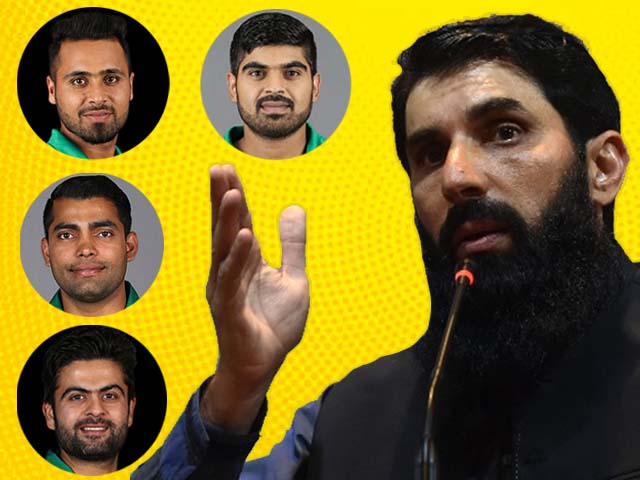
Pakistan's captain Sarfaraz Ahmed leads his team off of the pitch after winning the 2019 Cricket World Cup group stage match between England and Pakistan at Trent Bridge in Nottingham, on June 3, 2019. PHOTO: AFP
For Pakistan, the journey to World Cup 2023 starts now
Truth is the Pakistan team does have many promising cricketers, but we need a proper system to foster their talent.
Wednesday marked the end of Pakistan’s World Cup campaign. England held their nerve to trounce both India and New Zealand, making Pakistan’s progression to the semi-finals virtually impossible. Even if Pakistan manage to defeat Bangladesh, their poor run rate will make it very difficult for them to qualify for the next round of the World Cup. As usual, Pakistan’s campaign was filled with plenty of emotions, highs and lows, elation and disappointment. But now, as Pakistan teeter on the brink of elimination, now is the time to reflect on our team and ascertain what needs to change.
Many are saying that the likes of Shoaib Malik and Mohammad Hafeez should now bow out and make room for younger players, while others are questioning whether Sarfaraz Ahmed is the right person to lead the team. Although Pakistan’s most recent results in the tournament were good, the victories shouldn’t mask the most obvious issue within Pakistan cricket – the domestic cricket set-up.
I follow the domestic circuit religiously and I’ve spent countless hours watching the awful broadcasting quality of Pakistan’s domestic cricket. Not only is the camera work and commentary terrible, the quality of cricket is too.
While the cricketers may be talented, the fitness levels on display are absolutely shocking. The majority of the cricketers are unable to run well between the wickets, fielders take an eternity to reach the ball and the overall standard of cricket being played is extremely poor.
This low agility probably has a correlation with the average age of the teams. While there are no exact figures, I would wager that Pakistan’s domestic teams probably have the highest average age out of any domestic competition in the world.
This is due to the preferential ‘senior treatment’ that is prevalent in Pakistan cricket. A young talented cricketer will almost always be left out in favour of a senior player, simply because of their age. It is only until these players reach the age of 40, and physically cannot play anymore, that they choose to move on. But by then they’ve already deprived some young cricketers of a few crucial years of development.
One example of this is Misbahul Haq. What on earth is he doing still playing domestic cricket? I find it extremely selfish because him playing domestic cricket does not benefit Pakistan in any way. He would be best used as a coach or a mentor and currently he is blocking the path for many deserving youngsters. How can we expect to develop talent when older players are hogging the domestic circuit?
Furthermore, we often hear about the ‘high performance camps’ which are scheduled to develop players, but they honestly serve no point whatsoever. They last around three weeks in a calendar year, but what about the other 49 weeks? I feel that instead of this, every domestic team should be assigned a trainer and a dietician to maintain a certain standard of fitness within the squad. A yo-yo test should be made mandatory for each domestic side, and should a player not reach the required level, he should be dropped.
Additionally, each team should have a head coach, a batting coach, a bowling coach, a fielding coach and fans should know exactly who they are. Currently, I can’t name more than three coaches in the domestic circuit that I am aware of.
The benefits of the Pakistan Super League (PSL) have been discussed at length, but there are still some issues in that league which need to be resolved. The selection, inclusion and removal of players in the PSL is done with zero accountability. As a result, many talented youngsters spend the entire tournament on the bench.
How is it possible that during four years of the PSL, one of Pakistan’s best upcoming batsman, Saud Shakeel, has not even played a single game? On the other hand, you have the likes of Rishabh Pant from India playing every game in the Indian Premier League (IPL). This is the difference, and this is why India is doing so well on the world stage right now.
In order to give young cricketers a platform, the Pakistan Cricket Board (PCB) must change the number of overseas cricketers that are allowed to play in the PSL. I would suggest that only two-thirds of each playing 11 should be comprised of foreign players. It is imperative that our new and young cricketers are given the exposure and the platform to learn and grow as players. This is more important for the future of Pakistan than having random overseas cricketer playing in the PSL. The likes of Saif Badar, Zeeshan Malik, Hasan Mohsin and Saud Shakeel should be playing every single game in the PSL.
While deserving cricketers get excluded from the PSL, many undeserving cricketers get selected. One such example is Nabi Gul. I’ve watched Gul bat numerous times in domestic cricket and he averages just 18 runs in T20 cricket. Despite this, he was selected in the PSL and somehow got the opportunity to play in the PSL final. Such favouritism needs to be curbed.
Importantly, having to play in the United Arab Emirates (UAE) has also damaged Pakistan cricket. The pitches in the UAE are very slow and it is impossible for a batsman to develop and enhance his game out there. Not only that, the crowd turnout is generally quite low, making the atmosphere rather unexciting.
The PCB also needs to arrange more tours for the Pakistan A team and the Under-19 team in order to provide the next generation with some international experience. Under Dav Whatmore, we used to regularly see the Pakistan team play against Pakistan A in a televised match. I think that was a fantastic idea and should be reintroduced.
That leads me to my next point. Pakistan domestic cricket needs better coverage. Although Pakistan Television (PTV) has been great at supporting domestic cricket, the overall quality of their transmission is terrible and extremely off-putting. The broadcast needs to be better so that Pakistan’s domestic games are passionately followed in the country and around the world. Currently, very few people care about domestic cricket in Pakistan; however, in the United Kingdom (UK), you’ll find many die hard supporters of their domestic circuit. Ideally, this is how it should be in Pakistan too.
The road to the 2023 World Cup starts now. We must not get to 2023 having made zero progress. We must remember this feeling of being hurt at our inability to qualify for the semi-finals and we should use it to fuel a comeback. The truth is that the Pakistan team does have many promising cricketers, but we need a proper system to foster their talent. I have been harping on about the need for these changes for seven years now and I sincerely hope that the PCB will now look to develop a long-term strategy.
After today’s match, it is time for the PCB to look to the future and nurture the talent which will represent us at the 2023 cricket World Cup. Our veteran cricketers have had a good run, but now it is time for change. Out with the old, in with the new.




COMMENTS
Comments are moderated and generally will be posted if they are on-topic and not abusive.
For more information, please see our Comments FAQ